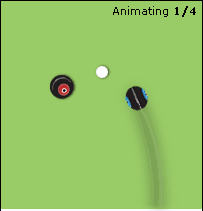A Basic Introduction: how the game is played
The Game of Bowls
The social, competitive game of bowls has been played for centuries. In the manufacturing process one side of the bowl is formed to be wider and heavier; this gives the bias. Marks are engraved indicating which is the lighter side and which is the heavier (biased) side. The bowl, when in motion, will veer to the left or right, according to the bias. The delivery is accomplished by standing on the mat and using the bowling arm as a pendulum to propel the bowl along the rink in the direction of the jack, where it will (hopefully) come to rest, either touching or adjacent to the jack.
Jack: White or Yellow, 6.35cm diameter. It must be delivered in excess of 23 metres.
Bowl: 12-13cm diameter, of 1.25-1.6kg, has imprinted stamps to denote brand, date, weight and size.
Types of delivery, Tactics & Scoring
The Draw
Allows the bowler to deliver the bowl to a specific location without disturbing other bowls at the 'head', (where bowls already played have come to rest).
Controlled Weight
Involves delivering the bowl with enough force to move the jack, or disturb other bowls at the head.
The Drive
Involves bowling with considerable force. The aim is to remove a specific bowl, or completely change the head. There is a very little curve in this shot as the speed of the bowl nullifies its bias.
Tactics
Includes the use of 'blockers' and 'covering bowls' and 'plants' to win ends.
How Scores are Applied
Scoring systems vary for different competitions. The winner is usually the first player, or team, to reach 21 shots, or the highest score after 11, 18, or 21 ends. Another system used is "set play", where the first to reach seven shots is awarded a set, with the match played over best-of-three, or five sets. When all the bowls have been played, a competitor, or team, gets one (shot) for each of their bowls that is closer to the jack than the opponent's closest bowl. After the score has been agreed and noted, the direction of play is reversed, with the team that won the end starting the next.
Measuring
Various types of measuring devices are used for checking distances. See the pictures below.
Continuing Play
Play continues until all ends have been completed, or one player / team concedes because they cannot 'catch up'.
An animated example of scoring

Measuring implements: calipers, long string, measuring tape



Stickers

To distinguish one club's bowls from others, stickers are attached to both sides of each bowl. The large circular roundel goes on the opposite side to the bias, which is indicated by the small, solid spot.






